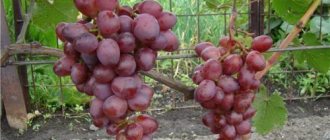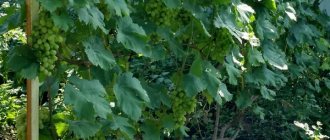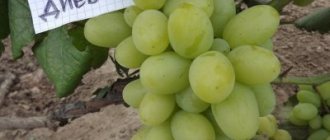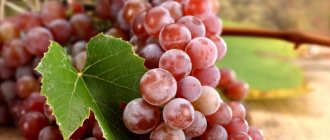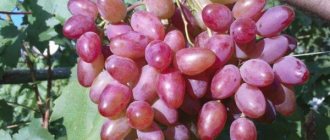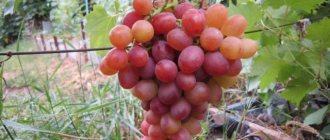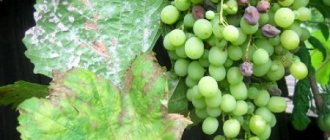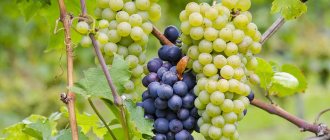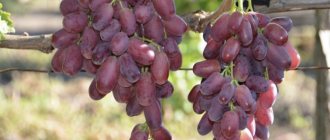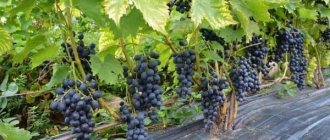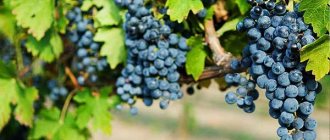Hamburg Muscat is a universal variety. It was very popular in the last century and occupied large areas in the fields of large agro-industrial complexes. Gradually, it began to be pushed aside by new hybrid plants, with greater resistance to fungal diseases, larger clusters and berries. But to this day, many farms continue to grow this unique variety, thanks to its nutmeg smell, beautiful dark blue berries with a slight haze, good transportability and universal purpose. How to grow a good harvest of Hamburg Muscat on your plot and its morphological characteristics will be discussed in this article.
Description of the variety
This variety is more common in the grafted viticulture zone and in the Crimea. The bunch is not dense, loose, beautiful with large dark blue berries covered with a visualized waxy coating. Muscat Hamburg is very demanding on weather conditions. Because in unfavorable weather conditions, fertilization of flowers is difficult and, as a result, half-empty bunches with small peas are formed. The taste of the berries is pleasant with a pronounced nutmeg aroma. The grapes belong to the varieties of medium ripening period. Tolerates transportation and storage well. It can be used not only for fresh consumption, but also for making wines, liqueurs and marinades. Read about the Long-awaited grape variety here.
This grape variety is grown almost all over the world.
Recommended for cultivation in the southern regions of the country.
Muscat Hamburg grape variety
Hamburg Muscat grapes stand out among Muscat varieties for their color, because usually these species, grown mainly for winemaking, have light berries. Hamburg Muscat is a representative of blue shades of fruit, which is what distinguishes it from other varieties, as can be seen from numerous photos.
Muscat Hamburg grapes
Properties
Grapes are a valuable gift from nature to man. And not because the berries are delicious. There are simply few cultures on Earth that combine taste and medicinal properties. For example, one kilogram of grapes contains about 200 grams of glucose, which, when entering the human body, releases from 600 to 1000 calories, which is approximately a third of the required requirement. The berries contain a large number of amino acids necessary for the human body, such as leucine, glycine, arginine, cystine, etc. Their value is that they are very easily absorbed by the body and take an active part in the synthesis of dermal proteins, vitamins, and hormones. Regulate fat metabolism (methionine), stimulate growth processes (lysine). Catechins and flavonols neutralize the results of radioactive radiation. And pectin substances exhibit an antitoxic effect and remove heavy metals from the body.
Grapes contain a large amount of antioxidants that have a beneficial effect on human health.
Calorie content
No specific compounds were found in grapes that were not found in other vegetables or fruits. But unlike them, you can eat up to 2 kilograms of grapes per day. At the same time, a sufficient amount of protective substances enters the human body, even if they are in small doses in the berries. At the same time, some people are afraid to eat grapes in such quantities, citing the fact that they are a high-calorie product. But nutritionists include grapes in all kinds of diets for certain diseases. There is a common belief that calorie content depends on the color of the berries. This is not entirely true, because the energy value of the product has nothing to do with color, but is directly dependent on sugar content. The calorie content of Hamburg Muscat is 65 kcal per 100 grams of product. Some white varieties have higher calorie content. Read about the calorie content of the Isabella grape variety here.
Its purple-blue berries taste great with a strong nutmeg aroma. In Russia it is grown as a cover crop.
White raisins have the highest calorie content - 95 kcal per 100 grams of berries.
Benefits and harms
The healing properties of grapes have been known since ancient times. In Russia, more than a hundred years ago, the doctor V. M. Dmitriev became interested in this. Ampelotherapy (treatment with grapes) in combination with health path (walking with certain physical activities) affects the normalization of heart rate and blood pressure. Congestion in the vascular system is eliminated, well-being, shortness of breath, appetite and sleep improve. Therefore, grapes are included in diets for the following pathologies:
- Cardiovascular diseases, hypertension;
- Metabolic disease;
- Reduced acidity of gastric juice;
- Chronic catarrh of the upper respiratory tract and gastric catarrh;
- Liver and kidney diseases.
That is, grapes are a crop with good preventive action and medicinal value.
At the same time, as Professor S.R. Tatevosov wrote, self-medication with grapes is unacceptable. You need to know the effect of each variety on the body. In addition, excessive consumption of berries and juice can be harmful in case of increased stomach acidity, diabetes mellitus, and obesity. Also, the acids found in berries have a bad effect on tooth enamel. Lydia will tell you this material about the benefits and harms of grapes.
After eating grapes of any variety, you should rinse your mouth with clean water.
Acidity
Grape juice contains more than ten types of different acids. They, formed from the incomplete oxidation of amino acids and salts, participate in the processes of biosynthesis of proteins, fats and carbohydrates. It is thanks to the acids in wine materials that the number of pathogenic microorganisms decreases, and wine yeasts begin to work intensively. And in the right ratio of sugar content and acidity, the result is a wine with an exquisite taste. This fully applies to the Muscat Hamburg grape, since its application is universal. The amount of acids in the juice during the ripening period of grapes is not the same. The acidity level decreases when:
- Ripening grapes;
- Heat treatment;
- Long-term storage.
Hamburg Muscat has good sugar accumulation (16-22%) and acidity ranges from 6 to 8 ppm. These are indicators of medium (5–7 g/l) and high acidity (7–9 g/l).
Depending on the amount of acids, the indicator can be low, medium, high and very high.
To obtain high-quality wort, professional winegrowers, determining the sugar content and acidity conditions, determine how best to use Hamburg Muscat grapes.
Characteristics of the bush
In order to grow a good harvest of grapes and apply certain agrotechnical techniques in a timely manner, you need to know the structural features of the bush of that variety. In this case, Hamburg Muscat, universal in purpose. Features of the variety:
- The bushes are medium-sized;
- The leaf color is green . They are five-lobed, slightly wavy. The leaf blade is medium-sized and large. There is a feeling of swelling. The teeth may have a reddish tint;
- Flowers are bisexual , collected in inflorescences;
- The bunch is loose. The berries are medium and large in size. Dark blue in color, covered with a visualized waxy coating. The taste is pleasant, with a pronounced nutmeg aroma. The consistency is meaty.
Vine
The stem is represented by annual and perennial parts. Perennial - stem, head and sleeves. Annuals are segmented, consisting of nodes and internodes. If annuals have clusters, then they are called fruitful, and if not, then they are called sterile. Annual shoots of Muscat Hamburg grow quickly and reach 3–4 meters by the end of the growing season. These shoots are characterized by the fact that under favorable weather conditions they ripen well. But if there is not enough heat and it rains often, then without the necessary preventive and therapeutic measures, the vine is affected by fungal diseases and does not ripen well. Ripened shoots are brown with reddish-brown nodes. Find out about the characteristics of the Augustine grape variety at this link.
On the bushes of this grape variety, 60 to 70 percent of fruiting shoots develop.
Bunch
The clusters are medium in size, but with good care they can be large. If weather conditions are unfavorable, then pollination is poor and the clusters end up with sparse, small, pea-shaped berries . But brushes up to 20 cm long and 17–18 cm wide still predominate. The weight fluctuates around 300 grams. The bunch is loose, branched, conical. The berries are fleshy with a pleasant, pronounced nutmeg aroma. They are oval in shape, rich dark blue in color with a visualized waxy coating. The weight of each varies from 3 to 5 grams. The berry has quite large seeds. True, there are only 2 to 3 of them there. The skin is dense, so the grapes can be stored for a long time and also tolerate transportation well.
The bunch has an elongated, slightly cone-shaped shape and weighs on average 160-270 g. The berries on the bunch are located quite densely.
The largest bunch grew in vineyards in Chile. Her weight reached 9.5 kg. Among domestic varieties, Preobrazhenie has a large cluster. So far, the record for a bunch of this variety is 8 kg 600 g.
Productivity
When choosing a variety for planting in their garden, many lovers look not only at the appearance of the cluster or berries, but pay special attention to the yield. Everyone wants to get a large quantity of good quality grapes. It is precisely this indicator that is the weak point of Hamburg Muscat. In the case of unfavorable natural conditions, pollination becomes difficult, and sparse clusters with rather small, pea-shaped berries are obtained.
With proper and timely agrotechnical measures and good sunny, warm weather with a minimum number of rainy days, this variety can produce from 70 to 120 centners per hectare with shoot fertility of up to 70%.
To increase the yield of grapes and its sugar content, the following techniques can be recommended:
- Increase bushes using a trunk;
- For four fruiting shoots, leave two fruitless shoots.
In years with insufficient heat, it is necessary to carry out foliar feeding with microelements necessary for the crop.
Muscat of Hamburg
(Frankenthal x Muscat of Alexandria) [Variety bred in England for greenhouse culture] Synonyms: Black Hamburg, Fekete Muskotaly, Moscatel Negro, Moscatel Negro De Mesa, Moscatel Negro Gordo, Moscatel Nero, Muscat d'Hambourg, Muscat d'Hamburg Muscat de Hamburg, Muscat de Hamburg, Muscat de Hamburgo, Black Muscat of Alexandria, Salamanna Rossa, Tamaiioasa Hamburg, Tamaiioasa Neagra, Tamaioza Nyagra, Tamiioasa Hamburg, Tamiioasa Neagra, Temyioasa Nyagra), Hamburg Misket, Zibibbo nero, etc. Hamburg Muscat is a table (universal) grape variety. It has become widespread in France, Hungary, Romania, Greece, Tunisia, and is found in the USA, Argentina and other countries. The crown of a young shoot is covered with thick felt pubescence, pinkish-white, with wine-red teeth. Young leaves have cobwebby pubescence on top and thick felt pubescence below. Their color is green with bronze spots and a wine-red border of the teeth. One-year-old mature shoot is brown, the nodes are reddish. The leaf is medium-sized and large, heart-shaped, medium- and deeply dissected, five-lobed, wavy, with corrugated edges. The upper notches are of medium depth, closed, with a narrow elliptical or ovoid lumen, sometimes open lyre-shaped, with almost parallel sides, the lower ones are small, open, slit-like or in the form of a recessed angle. The petiole notch is closed, with an elliptical lumen or open, lyre-shaped. The teeth at the ends of the blades are elongated, sharp, triangular. The marginal denticles are triangular, one-sided convex, sharp. The pubescence of the lower surface of the leaf is sparse, cobwebby, and bristly on the veins. The flower is bisexual. The bunch of grapes is medium-sized or large (18-20 cm long, 11-17 cm wide), conical, branched, sometimes winged, loose. The stem of the bunch is medium long (4-6 cm), grassy green. The mass of the bunch is 168-267 g. The berry varies in size, mostly large (12-26 mm long, 11-17 mm wide), often pea-shaped, round and oval, violet-blue, with a thick waxy coating. The skin is relatively dense. The pulp is fleshy and juicy. The taste is very pleasant, with a subtle original nutmeg aroma. The average weight of 100 berries is 310-415 g. There are 2-3 large seeds in a berry.
Related article: Grape variety Narma
Growing
Muscat Hamburg grapes can be planted either as grafted seedlings or as self-rooted ones. But the latter is practiced only in regions with slight winter temperature drops. It is better to buy grafted seedlings in specialized nurseries, and not on the market. This is a guarantee that the purchased planting material will be of the desired variety. In addition, during the period of preserving seedlings in the basements of agricultural enterprises, the required humidity and air temperature are controlled. And the planting material there is certified.
It is better to lay out an area for a vineyard in a well-lit area. Not in lowlands, so that water does not stagnate there in the future. Grapes grow well on chernozems, chestnut, sandy loam soils. This article will tell you a description of the Aleshenkin grape variety.
Rows in vineyards are best placed from north to south.
Planting period
Planting a vineyard can be done in autumn or spring. Autumn is the best time for planting only in the southern regions. In all the rest, located to the north, planting is carried out when the soil warms up to 6–8 degrees. It is at this time that the grapes begin to “cry”. That is, juice drips from the cut vine. If planting is done with kilch chibouks, then you need to wait until the soil temperature rises to 10 or even 12 degrees.
Autumn planting of grapes is carried out after the leaves have fallen. The best time for this is considered to be the end of October - November. In autumn, planting of chibuks is not carried out.
In order for the grapes to actively develop and produce a bountiful harvest, you need to plant the cuttings on the south or southwest side.
During autumn planting, the mounds are made higher and wider than during spring planting.
Ripening period
Hamburg Muscat is a medium-ripening variety. Mass harvesting begins in September. Almost 5 months (140–150 days) pass from the beginning of buds to the appearance of ripe berries. Heat requirement 2700–2900 (sum of temperatures in degrees). Therefore, it ripens faster on slopes, where the sum of temperatures is 300 degrees higher than on plains or valleys. And the frost-free period there is 20 days longer. The brushes are relatively small and, depending on the load, there may be 1–2 pieces on the shoot.
The variety is transportable and tolerates transportation well over long distances. It also has a long shelf life. Universal use. They are used both for fresh consumption and for making wine and juices.
Muscat Hamburg -
high-quality table grape variety of mid-late ripening European species
Libya and Veles are considered one of the earliest grape varieties, the harvest from which can be harvested 100-105 days after bud break.
Features of variety propagation and planting cuttings
Grapes of this variety grow well in loam, sandy loam and sandy soils. It is advisable to place it on southern and southwestern slopes. If this is not possible, then you should choose an area well lit by sunlight.
Grapes can be propagated both by cuttings and seedlings. The best time for planting is autumn: late October - early November. The cuttings are taken in the spring, before flowering. Then they are rooted and stored in the cellar during the winter. In summer they are sprouted.
When planting cuttings, it is necessary to maintain a distance of 1.5 m between them. The row spacing should be 2–2.5 m.
After planting, the cuttings are covered with plastic bottles, watered using 3-4 buckets for each plant, the soil is loosened and a mound of earth 30 cm high is poured on top to insulate the root system.
Care
Caring for Arcadia and Muscat Hamburg grape varieties is simple and consists of the following operations:
- Checking the condition of the mounds after planting and shoots.
- Shaping the bush.
- Timely catarrhization, that is, removal of additional roots on the rootstock.
- Loosening row spacing.
- Spraying bushes with Bordeaux mixture to prevent fungal diseases.
- Root and foliar feeding.
- Irrigation. Grapes can bear fruit on rain-fed lands. But a good harvest is only possible with irrigated crops. Drip irrigation is best suited for this operation.
- Coinage. It is carried out at the beginning of fruit ripening.
- And also dry garter, debris, garter of shoots.
Grapes do not like large amounts of moisture, so watering must be strictly controlled.
Disease Prevention
Hamburg Muscat grapes are poorly resistant to diseases such as mildew, oidium, phylloxera, gray rot, and bacterial cancer. The Rkatsiteli variety is also susceptible to oidium. Therefore, it is necessary to carry out timely preventive treatments of vineyards against these diseases. Treating bushes with Bordeaux mixture will be a good barrier against fungal diseases. This needs to be done starting in the fall. As soon as the leaves fall, the bushes and the soil near them are treated with a freshly prepared solution of iron or copper sulfate with lime. In the spring, the vineyards are treated with the same solution before the buds open and a third time along the shoots. If phylloxera appears, the bush must be uprooted and destroyed.
Oidium is a very common disease among this variety.
When spots appear on the leaves, you must urgently switch to treating the bushes with phytoncides. Bordeaux mixture will no longer help.
Trimming
To make it easier to care for the bushes and maintain them in the phase of continuous fruiting, they are given one form or another. These can be standard-free (fan) or standard forms. Hamburg nutmeg is formed according to the principle of double-armed Guillot or a standard-free fan form. From 18 to 20 shoots are left per bush, of which 10-14 are fruiting. This variety has poor frost resistance, so using the Guillot method, 4-6 buds are left on the vine, since in this variety the fruiting buds are located closer to the base of the shoot. The load on the bush should not exceed 20 shoots. At least half of them bear fruit. Standard double arms are used in the southern regions of the country.
When there is a lack of moisture, short pruning gives the best results.
Harvest and storage
In addition to the fact that the grape harvest must be successfully grown, it must also be harvested on time. Delays or haste in harvesting threaten to deteriorate the taste of the berries. In addition, you should focus on the purpose for which the crop is harvested. If it is planned to process it, then harvesting must begin in a state of technical ripeness.
If the grapes are consumed fresh or dried, then you should wait until they contain the greatest amount of sugar, that is, the moment of biological maturity.
The following signs indicate the ripeness of the grapes:
- The color of the berries is close to the declared varietal characteristics.
- The berries are separated from the stalk without much effort.
- The berries are sweet, without strong acid.
- The seeds are brown and easily separated from the pulp.
- The nutmeg aroma is well captured.
Harvesting is planned for dry weather during the daytime. Ideal conditions are air temperature +16…+20°С. Morning and evening are not suitable for collection due to the presence of dew.
The bunches are cut manually with a knife, pruning shears or scissors. It is important not to pull the brush so as not to damage the vine. Next, the bunches are placed in buckets, baskets, boxes and transported to the storage location.
Only brushes with intact, large, fully ripened berries should be placed for storage. Before planting, you need to carefully remove from the bunch all crushed, rotten fruits that have damaged skin.
Storage is carried out in a cellar or basement, in which air circulates well and the temperature is maintained at +1 ... + 8 ° C, humidity 80%. The bunches can be stored horizontally, folded in plastic or wooden boxes, on shelves, and also in a suspended state - on a wire or rope.
Exhibition budgies: yellow, white, blue - choose any one for yourself
You can also store grapes on the bottom shelf of the refrigerator. Before storing it, it is strictly forbidden to wash it, as this significantly reduces its shelf life.
If stored properly, grapes are suitable for consumption within 2–3 months. To preserve the berries for a longer period - up to 1 year, they can be frozen. Hamburg Muscat berries have a universal purpose. They are consumed fresh, wine, juices, liqueurs, and marinades are made from them.
To summarize the above, we note that the Hamburg Muscat grape variety is suitable for cultivation in regions with a warm climate. For its successful cultivation, it is necessary to equip a good irrigation system, properly prepare the soil and carry out high-quality care.
conclusions
The Hamburg Muscat variety has both its advantages and disadvantages. Positive traits:
- Varieties Hamburgsky and Marinovsky for universal use.
- The berries are dark blue , up to 2 cm in length, with a visualized waxy coating.
- The pulp is juicy, with a high percentage of sugar content. The taste is pleasant, with a pronounced nutmeg aroma.
- High, although unstable, yields. Under favorable conditions, it is possible to collect up to 120 centners of berries per hectare.
- Good keeping quality and transportability.
Disadvantages of the Muscat Hamburg variety:
- Instability to fungal diseases , phylloxera.
- The tendency of berries to peas.
- The variety is not frost-resistant . The eyes are damaged when the temperature drops to 18 degrees. Therefore, it is recommended for cultivation only in the southern regions of the country.
Advantages and disadvantages of the Muscat Hamburg grape variety
- Among the main advantages of the variety should be mentioned:
- excellent shelf life and transportability;
- wonderful taste of berries;
- universal application;
- ability to self-pollinate.
- Unfortunately, the variety also has many disadvantages:
- demanding weather conditions;
- the volume and quality of the harvest strongly depend on the climate;
- Suitable for growing only in warm climates;
- weak resistance to major diseases;
- low frost resistance;
- frequent peas of berries.
